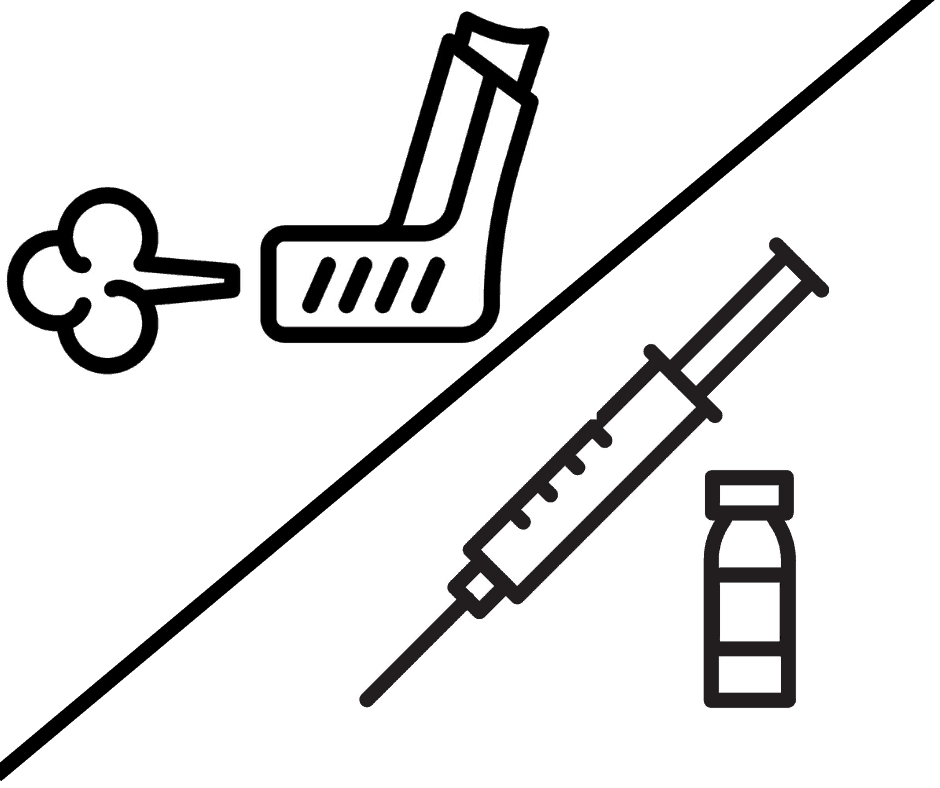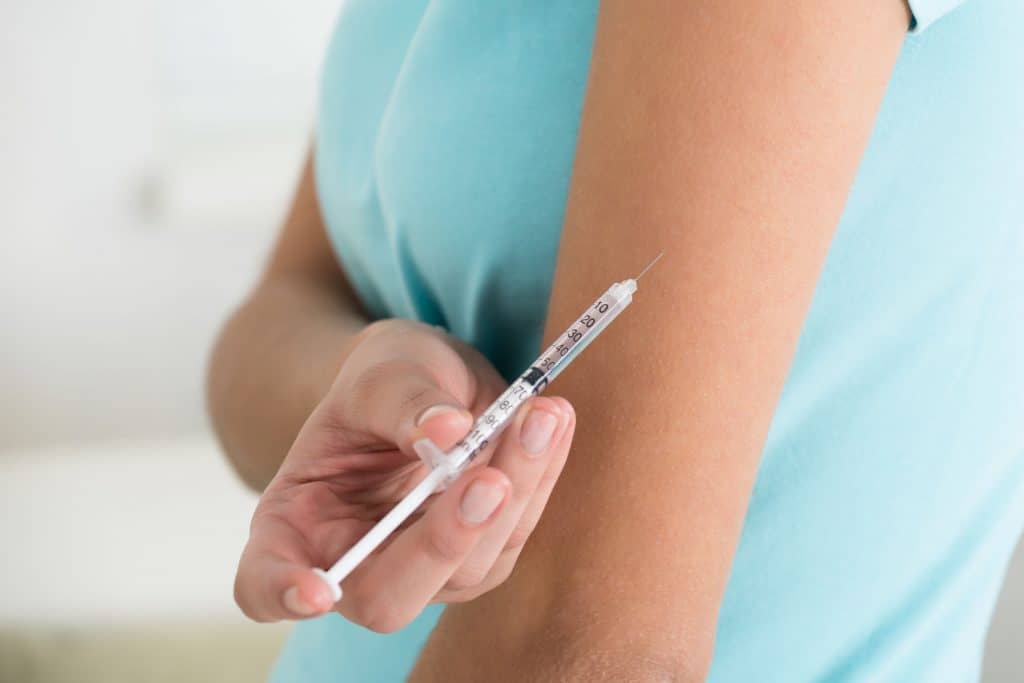Inhaled vs Injected Insulin – Similarities, Differences, Costs, A Guide
Posted by Prescription Hope - See Editorial Guidelines (Last Updated On: Fri Jan 26 2024)
Many individuals that have diabetes have to take insulin. However, they may ask themselves, which insulin is best for them? So, between inhaled and injected insulin, which is better?
 Before we get into too much detail of inhaled vs injected insulin, here’s a quick takeaway answer for you.
Before we get into too much detail of inhaled vs injected insulin, here’s a quick takeaway answer for you.
Inhaled vs Injected Insulin: Inhaled insulin is administered similar to that of an asthma medication. Injected insulin comes typically in the form of a pen with a small needle, which is injected subcutaneously. The units and the way the insulin is measured between the two differ, but both work to bring blood sugar back into the normal range after meals.
In this article, we will outline everything you need to know about inhaled vs injected insulin.
Inhaled Insulin Described
Inhaled first hit the market back in 2006 under the name Exubera and was manufactured by Pfizer. Exubera only lasted just over a year and was discontinued in October 2007. Patients and medical professionals were not attracted to this inhaled insulin product. The sales of Exubera were simply too low.
Inhaled insulins were nonexistent for nearly 7 years before a new one hit the market.
The only inhaled insulin on the market at this time is Afrezza, which was approved by the FDA in 2014. Afrezza is a rapid-acting insulin that is inhaled at the beginning of your meal.
If you have type 2 diabetes and your healthcare provider suggests that you need a rapid-acting insulin, then it may be beneficial to discuss inhaled insulin.
Inhaled insulin passes through your lungs and into your bloodstream. This allows insulin to get into the bloodstream quickly. Inhaled insulin can start reducing blood sugar levels within 12 minutes. Once in your system, the insulin will last between 1.5-4 hours, depending on the dose.
The inhaled insulin is administered through an inhaler. Cartridges are inserted into the inhaler, which contains the medicine. The cartridges come in doses of 4, 8, and 12 units.
Those that are interested in using inhaled insulin should not smoke, have asthma, have COPD, or other lung problems.
Injected Insulin Described
There are a variety of injected insulins, which are split into two main categories – rapid-acting and long-acting. Long-acting insulins include those such as Lantus or Levemir. Rapid-acting insulins include Novolog, Humalog, Fiasp, and Apidra.
Injected insulins will either come in the form of pens or vials. An insulin pen requires a small need that is screwed on and injected subcutaneously. A vial will require a syringe to pull the insulin from the vial. It can either be injected via the syringe or placed in an insulin pump.
Injected insulin pens come prefilled with 300 units of insulin. Some pens will allow ½ unit doses while others go by 1-unit doses. A vial of insulin contains 1,000 units of insulin.
The Differences of Inhaled vs Injected Insulin
As I’m sure you have noticed, there is a wide range of differences between inhaled vs injected insulin.
Perhaps, the most notable difference is how each insulin is administered. Injecting insulin daily at each meal can be very tedious and painful at times. By using the inhaled insulin, you are saving yourself from those multiple daily injections.

For some individuals, this is necessary, as they may have problems with needles or may experience injection site reactions.
On the flip side of inhaled vs injected insulin, the inhaled insulin only comes in limited doses (4, 8, and 12 units). This can limit an individual and may make it difficult to get the correct dose needed based on food consumption. Injected insulin allows more freedom for what dosage the patient needs.
Inhaled insulin is not a long-acting insulin. So, if you are a person that requires long-acting insulin, then you will have to use injected insulin. Injected insulins come in multiple forms, and inhaled insulin only comes in the one rapid-acting form.
Inhaled insulin may cause patients to cough after inhaling, especially if you are new to using it. This is not a common problem with injected insulin. Coughing immediately after inhaling insulin may prevent some of the medication from entering the body correctly. There is a chance that coughing immediately after inhaling insulin may affect the amount of the dose received. If this occurs, then blood sugar levels can be negatively affected. This is why people with lung problems should not use inhaled insulin.
Inhaled insulin may enter the bloodstream faster and stay in the system longer when compared to injected rapid-acting insulins. Studies determined that inhaled insulin remains in the system about as long as regular insulin, or Humulin R.
Inhaled insulin is not used to treat diabetic ketoacidosis (DKA). Injected insulin, on the other hand, is used to treat DKA. However, hospitalization is required where an individual is often placed on an insulin drip.
The Similarities of Inhaled vs Injected Insulin
The most significant similarity between inhaled and injected insulin is that they are used to treat high blood sugar. Inhaled and injected insulin can be used as mealtime insulins to prevent blood sugars from spiking too high.
Inhaled and injected insulins both have the potential to cause hypoglycemia, which can be life-threatening. Injecting or inhaling too much insulin can lead to low blood sugar.
Both inhaled and injected insulins can be used to treat type one and type two diabetes. Your doctor will suggest which insulin is right for you.
There are not many other similarities of inhaled vs injected insulins. Since both are forms of insulin, side effects may be similar for some individuals.
Safety & Efficacy of Inhaled vs Injected Insulin
The safety and efficacy of injected insulins are well established since they have been around for some time. However, how does inhaled insulin stack up against injected insulin?
In a study of patients with type 2 diabetes, they found that the individuals on inhaled insulin experience a similar A1c as those on injected insulin. The patients on inhaled insulin in this study didn’t experience a more prominent cough than those that weren’t taking the inhaled insulin. No other side effects or adverse reactions were different, though.
A study was also done on patients that have type 1 diabetes. Patients on the inhaled insulin experienced a higher risk of nocturnal hypoglycemia (low blood sugar levels at night). Patients also experienced a higher tendencies for coughing when using inhaled insulin. Overall, the study showed that inhaled insulin worked comparably to injected insulin.
It is important to note that these studies were not done with the most up to date inhaled insulin. There are not currently studies out showing how comparable Afrezza is to other injected insulins. However, the mechanism of actions for the past inhaled insulins is the same. So, these studies may provide some beneficial insight.
Regardless, every medication has to undergo testing and approval from the FDA to ensure safety and efficacy.
What Insulin Should You Use?
The insulin that you should use is highly based on your specific condition and your desire. Your doctor will suggest what they believe is best to treat your condition.
However, if you have lung problems, asthma, or if you smoke, then inhaled insulin is not for you. You should use an injected insulin to prevent farther complications and problems with your breathing.
If you are currently using an injected insulin and have injection site reactions, then consider switching to inhaled insulin. The dosing may not be the exact same, so follow your doctor’s instructions for how you should dose the inhaled insulin.
Cost of Inhaled vs Injected Insulin
The cost of inhaled insulin will range from $379 – $1,117 for 90 powder cartridges. The price will vary depending on the cartridge doses that you require. Keep in mind that this is the out of pocket cost. Some insurances will cover some of the expenses for inhaled insulin. A drug discount card or drug coupon may be available also.
A vial of injected insulin can cost between $174 – $300. For a pack of 5 insulin Humalog insulin pens, you can expect the price to be around $550. Again, this is the out of pocket cost. The price will also vary depending on the type of insulin you require.
Conclusion
We hope this helps you compare inhaled vs injected insulin, and to determine which one is best for you. If you have farther questions, then consult your healthcare provider.
If you are paying more than $60.00 a month through Prescription Hope’s medication access service for your insulin or other medication, then contact Prescription Hope. We work with 180 pharmaceutical companies to help provide medications at a set, affordable price. Enroll with us to find out if you are eligible.

